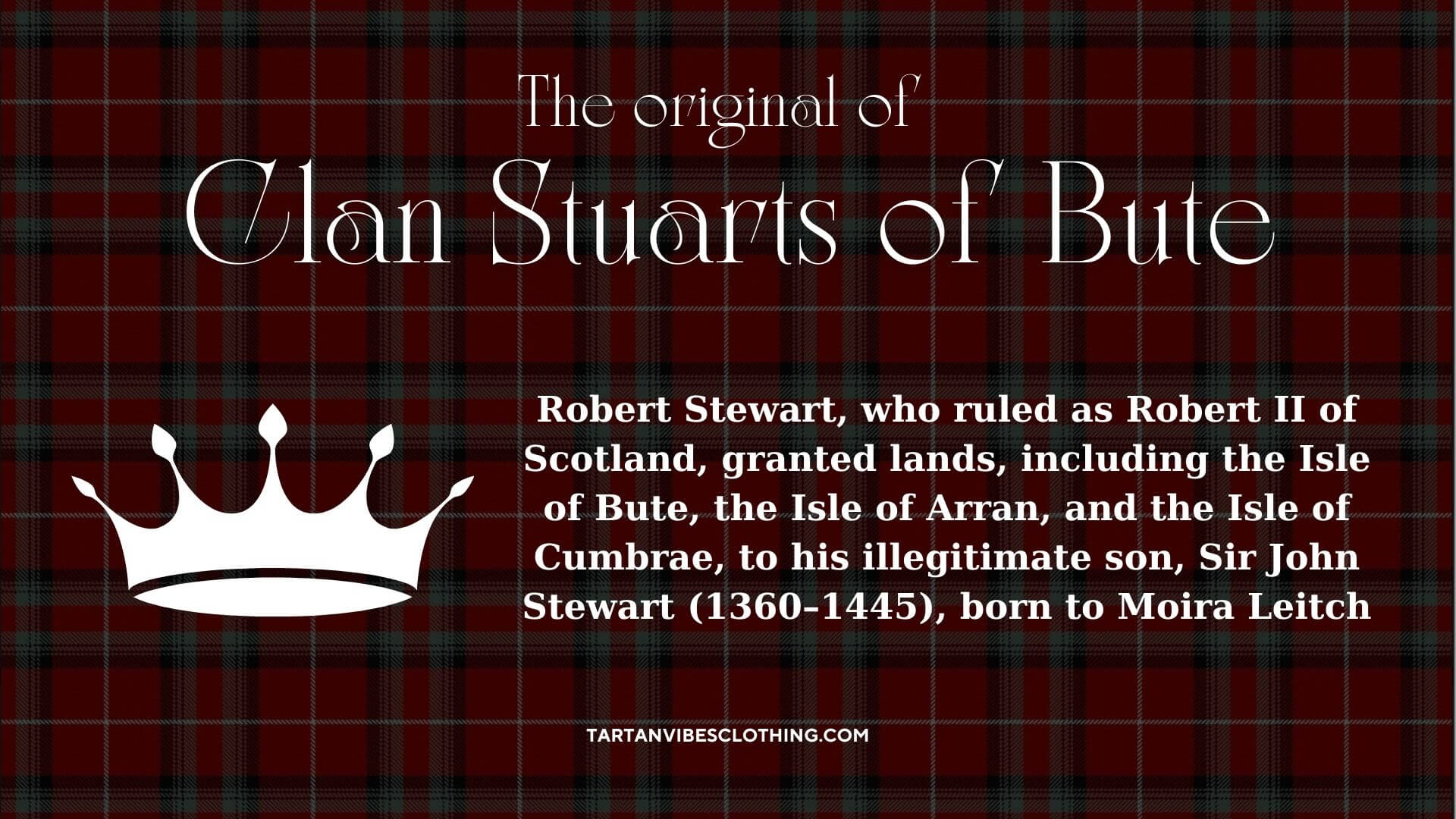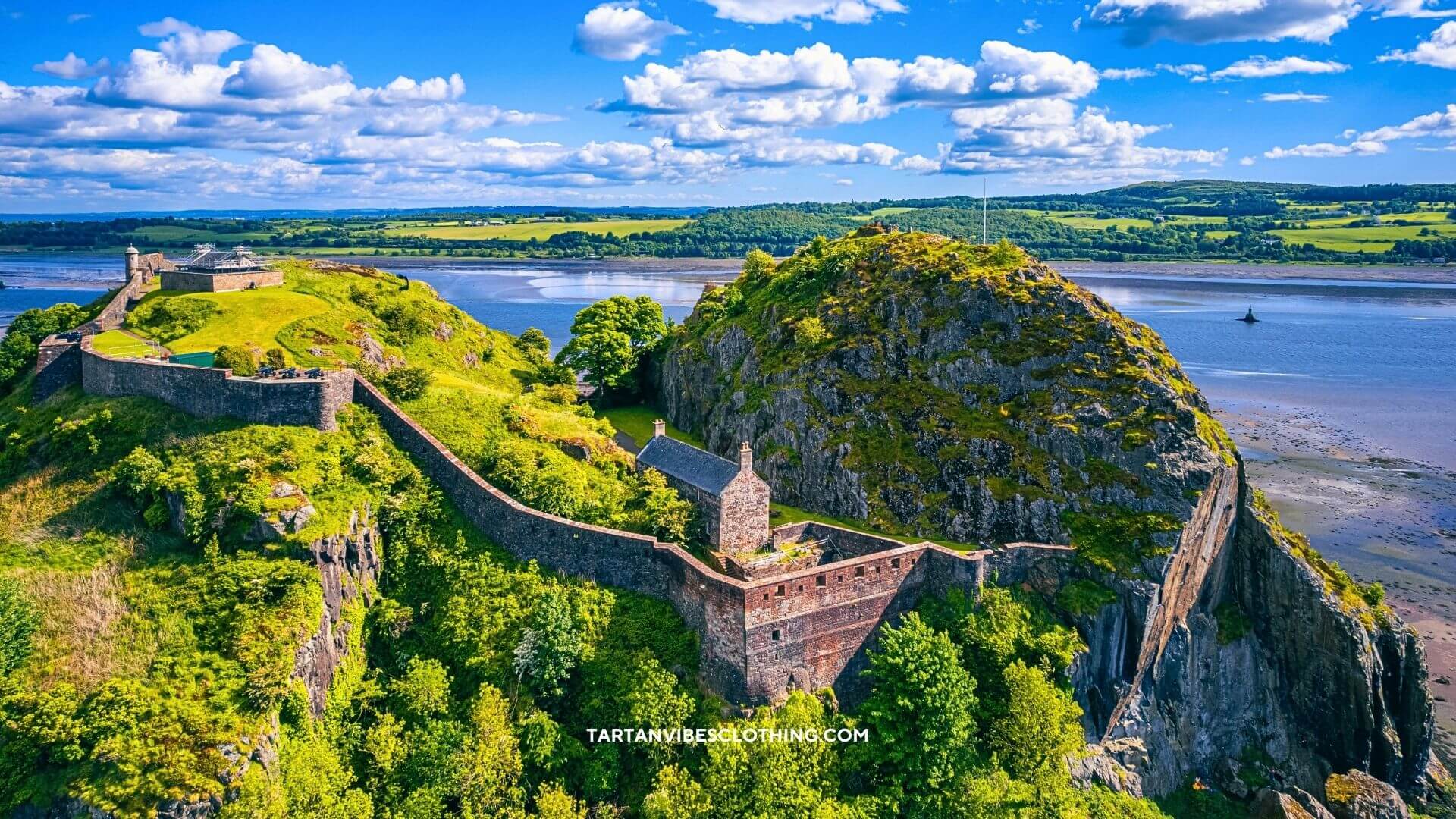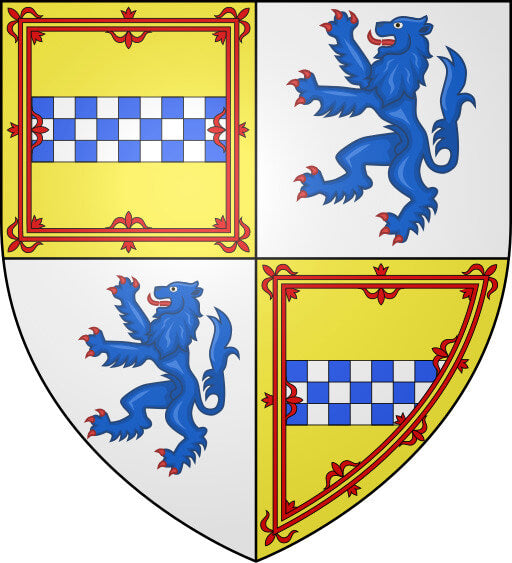Clan Stuart of Bute: Legends, History, and Scottish Pride
by Aimee Li on Aug 26, 2024
Table of Content
I. Introduction
The Clan Stuart of Bute is one of Scotland's most historically significant families, with a lineage that ties directly to the Royal Stuart. Their story is rich with legends, historical battles, and a lasting influence on Scottish culture and identity.
This article delves into the Clan Stuart of Bute's origins, notable figures, and enduring legacy, shedding light on their role in shaping Scottish history.
1. A Brief Overview of Clan Stuart of Bute
The Scottish Clan Stuart of Bute is a prominent branch of the Stewart Clan, named after their residence on the Isle of Bute, located at the mouth of the Clyde River near what was once known as Argyle County (Argyllshire) in western Scotland. The Clan Stuart of Bute exemplifies the rich history, traditions, and pride of families in Scotland.
This historic clan, with deep ties to the Isle of Bute, has significantly influenced Scotland's cultural and political landscape for centuries. From their beginnings as hereditary stewards for the Scottish crown to their lasting impact in contemporary times, the Stuart of Bute has significantly contributed to Scottish heritage.
2. The original of Clan Stuart of Bute
The Stewards or Seneschals of Dol from Brittany arrived in Scotland via Normandy and England when David I reclaimed his throne in 1124. They attained a prestigious position in Scotland, ultimately becoming the High Stewards. Through their union with Marjorie Bruce, the daughter of King Robert the Bruce, the Stewarts gained the Scottish throne following the death of David II, the sole heir of Robert the Bruce.

Robert Stewart, who ruled as Robert II of Scotland, granted lands, including the Isle of Bute, the Isle of Arran, and the Isle of Cumbrae, to his illegitimate son, Sir John Stewart (1360–1445), born to Moira Leitch (as tradition states). The king established these territories as a County and appointed his son as the Sheriff. This arrangement was ratified by a charter from Robert III of Scotland in 1400.
II. Clan Stuart of Bute History
1. In the 15th century
John Stewart (1360-1445) served as the first Sheriff of Bute from 1445 to 1449. He was followed in this role by his son, James Stewart, who became the second Sheriff of Bute. James's son, also named Stewart, took on the role of third Sheriff of Bute and was the father of Ninian Stewart. Ninian Stewart was officially recognized as Sheriff of Bute and was granted control over the lands of Ardmaleish, Greenan, the Mill of Kilcatten, and Corrigillis. In 1498, James IV of Scotland appointed Ninian Stewart as Hereditary Captain and Keeper of Rothesay Castle in Bute. This title remains with the family today, as reflected in their coat of arms.

2. In the 16th century
Ninian Stewart had three wives. His son, James Stewart, took over in 1539. James faced difficulties during the conflict between the Earl of Arran, Scotland's regent, and the Earl of Lennox. After James, his son John Stewart became the next in line and represented Bute in the Edinburgh Parliament. The family preferred the French version of their name, Stuart, which was brought in by Mary, Queen of Scots, and the current Chiefs still use this spelling.

3. In the 17th century and Civil War
On March 28, 1627, Charles I of England granted Sir James Stuart of Bute the title 1st Stuart Baronet of Bute in the Nova Scotia Baronetage. In the early stages of the Scottish Civil War, he defended Rothesay Castle and recruited soldiers for the king at his own cost. Stuart was named royal lieutenant for western Scotland. He intended to capture Dumbarton Castle, but two frigates sent for support encountered severe storms, destroying one. Consequently, Sir James Stuart had to escape to Ireland. After Oliver Cromwell's triumph, Sir James Stuart was compelled to pay a hefty fine to reclaim his confiscated estates.

Sir James Stuart's grandson, also named James Stuart, became Colonel of the local Militia following the Earl of Argyll's forfeiture in 1681. This James Stuart endorsed the rise of William of Orange and his spouse, Queen Mary Stuart.
4. In the 18th century and Jacobite Risings
During Queen Anne's reign, James Stuart became a Privy Councillor and Commissioner for the Treaty of Union negotiations. He was made 1st Earl of Bute on April 14, 1703, along with other titles in Scotland. However, by 1706, he opposed the union with England as he believed it wouldn't succeed and withdrew his support when Parliament favored it. He married the eldest daughter of Sir George Mackenzie.
After George I ascended the throne, James Stuart, 2nd Earl of Bute, served as Commissioner for Trade and Police in Scotland, Lord Lieutenant of Bute, and Gentleman of the Bedchamber from 1721 to 1723. During the Jacobite Rising of 1715, he led the Bute and Argyll Militia to maintain regional peace.

John Stuart, 3rd Earl of Bute, tutored Prince George, who later became King George III. The 3rd Earl served as Groom of the Stool from 1760 to 1761, joined the Privy Council, became First Lord of the Treasury, and eventually Prime Minister in 1762. He signed a treaty with France in 1763 that ended the Seven Years' War. His son, John Stewart, succeeded him, marrying Lady Elizabeth Penelope McDouall-Crichton. In 1796, he was elevated from 3rd Earl of Bute to 1st Marquess of Bute in the Peerage of Great Britain.
5. In the 19th century
John Crichton-Stuart, the 2nd Marquess of Bute, was a prominent Member of Parliament in the House of Commons and an industrialist who played a significant role in enhancing Cardiff's docks to compete with those in Liverpool. By the time his successor passed away in 1900, Cardiff had emerged as the world's leading coal port. John Patrick Crichton-Stuart, the 3rd Marquess of Bute, was an influential industrialist, historian, scholar, philanthropist, and supporter of architecture; he renovated Castell Coch and Cardiff Castle as honors to the artistic achievements of the Middle Ages and was appointed a Knight-Companion of the Most Ancient and Most Noble Order of the Thistle.

6. In the 20th century
John Crichton-Stuart, the 4th Marquess of Bute, had a strong interest in architecture and was honored as a Knight-Companion in the Thistle's Most Ancient and Noble Order. His son, John Crichton-Stuart, the 5th Marquess of Bute, a maternal descendant of William IV of the United Kingdom through Dorothea Bland, specialized in ornithology. He was followed by his son, John Crichton-Stuart, the 6th Marquess of Bute. He was dedicated to preserving Scottish heritage and was awarded a Knight-Commander title in the Most Excellent Order of the British Empire for his contributions before passing in 1993.

III. Clan Stuart of Bute Crest and Coat of Arms
1. Clan Stuart of Bute Crest
The combination of these symbols in the Clan Stuart of Bute Crest not only honors the clan's historical roots but also conveys enduring values such as readiness, resilience, and a connection to the fertile landscapes of their ancestral lands. The crest is a proud emblem, representing the identity and spirit of Clan Stuart of Bute's history across generations.
Clan Stuart of Bute
Crest: A demi-lion rampant, Gules, armed and langued, Azure
Motto: Nobilis Est Ira Leonis (The Lions Anger is Noble)
Lands: Bute, Arran, and Cumbrae
Clan Chief: John Crichton-Stuart, 7th Marquess of Bute

The Clan Stuart of Bute Crest is a distinguished emblem that perfectly captures the essence of strength and nobility, symbolizing the clan's pride. Central to the crest is a striking red lion rampant, an iconic representation of courage and valor with deep roots in Scottish heraldry. The lion's vibrant red color signifies bravery and passion, while its upright stance conveys the clan's enduring spirit and resilience.
Accompanying the crest is the Clan Stuart of Bute motto: "Nobilis Est Ira Leonis," which translates to "The Lion's Anger is Noble." This phrase reflects the clan's pride and tenacity, underscoring that true strength is tempered with honor and dignity.
2. Clan Stuart of Bute Coat of Arms

The Coat of Arms of Clan Stuart of Bute is a distinguished symbol that encapsulates the clan's heritage and noble legacy. This heraldic emblem reflects the clan's rich history, featuring intricate designs that showcase critical familial connections and values. The colors and powerful imagery within the coat of arms signify strength, courage, and loyalty, which are deeply respected within the clan.
IV. Clan Stuart of Bute Tartan
The Clan Stuart of Bute Tartan is a distinguished representation of Scottish heritage, typically characterized by a vibrant red background accented with soft green stripes. In contrast, the Clan Stuart of Bute Hunting Tartan features a rich purple base, beautifully complemented by bold green stripes, making it a standout choice for those with a keen appreciation for the outdoors.


This Clan Stuart of Bute Tartan has deep historical significance, tracing its lineage back to Sir John Stewart, who played a pivotal role in the lands of Bute, Arran, and Cumbrae after they were designated a kingdom by King Robert III. Sir John was appointed hereditary Sheriff of these lands in a Royal Charter of 1400, a legacy later carried on by James Stewart, who served as Sheriff of Bute from 1445 to 1449. Today, the Clan Stuart of Bute Tartan not only honors its rich history but also serves as a proud emblem of cultural identity for its wearers.
Set sail on an odyssey through the illustrious annals of Clan Stuart of Bute with our handpicked collection of tartan creations. Embody the indomitable spirit that characterizes the Stuart of Bute clan, weaving a piece of this noble history into the fabric of your daily existence:
V. Prominent Members of Clan Stuart of Bute
1. John Bryson Crichton-Stuart, 8th Marquess of Bute
The current Chief of the Clan Stuart of Bute is John Bryson Crichton-Stuart, who holds the title of 8th Marquess of Bute. He was born on December 21, 1989, and is the child of the 7th Marquess and his spouse Carolyn E. R. M. Waddell. He held the title of Lord Mount Stuart beginning in 1993.
On March 22, 2021, he took over his father's title as Marquess of Bute, established in 1796. Additionally, he became the 14th Stuart baronet in Nova Scotia's baronetage, which dates back to 1627.
2. John MacDonald Stuart (1815 - 1866)
Born in Fife, Stuart discovered his fiancée and best friend sharing a kiss, prompting him to take the first ship to Australia. Utilizing his civil engineering background, he secured a position as a draughtsman under the explorer Charles Sturt. By 1858, he led his expeditions, demonstrating remarkable speed, endurance, medicine, botany, and astronomy skills. A prize of £2000.95 was offered for mapping a route through central Australia suitable for the planned Overland Telegraph, and Stuart became the first individual to reach the continent's center.
However, it took him five tries before successfully traveling from the South coast to the North on July 25, 1862. The journey back south took a toll on his health, and he passed away a year after returning to London. The Overland Telegraph, which followed his route from Darwin to Adelaide, was finished in 1872.

3. Sir James Stuart
In 1627, Charles I conferred the Baronet of Nova Scotia title upon Sir James Stuart of Bute.
His grandson, Sir James Stuarts of Bute, became a Privy Councilor during Queen Anne's rule and was elevated to Earl of Bute, Viscount Kingarth, and Lord Mount Stuart, Cumra, and Inchmarnock in 1703. He was subsequently appointed as Commissioner for Trade and Police in Scotland, Lord Lieutenant of Bute, and a lord of the bedchamber. In 1715, he led the Bute and Argyll militia at Inveraray.
The third Earl of Bute, John Stuart, served as a friend and tutor to Prince George. When George ascended the throne as George III, John was appointed a Privy Councillor and First Lord of the Treasury. In 1763, he successfully negotiated a treaty with France that concluded the Seven Years' War.
VI. Conclusion
The Clan Stuart of Bute is a living embodiment of Scotland's rich history, with a legacy that has evolved through centuries of change and adaptation. From its origins as hereditary stewards to its modern-day relevance, the clan inspires pride among its members and resonates deeply within Scottish culture. The clan's iconic crest and tartan serve as powerful symbols of its enduring spirit. At the same time, prominent figures from history and contemporary society remind us of the impact of the Stuart of Bute on Scotland's journey.
Frequently Asked Questions
Are Stewart of Bute and Stuart of Bute the same clan?
The initial spelling was "Stewart," but as the Stewarts ascended to the royal family of Scotland and England, "Stuart" became more popular. Both versions denote the same clan and lineage.
What is the Stuart of Bute clan motto?
The Clan Stuart of Bute motto: "Nobilis Est Ira Leonis," which translates to "The Lion's Anger is Noble." This phrase reflects the clan's pride and tenacity, underscoring that true strength is tempered with honor and dignity.
Who can wear a Stuart of Bute tartan?
Royal Stewart Plaid is the tartan associated with Queen Elizabeth II. Theoretically, this implies that one requires the Queen's explicit consent to wear it. Fortunately, because of its widespread appeal, it is now recognized as a Universal plaid, allowing anyone without a personal clan plaid to wear it.
What is the clan crest of the Stuart of Bute?
Clan Stuart of Bute Crest: A demi-lion rampant, Gules







